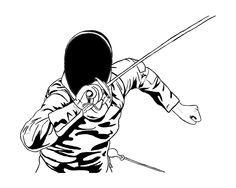Welcome to the May edition of the Newton Abbot & Totnes
Fencing club newsletter. In the next couple of months there are quite a
few fencing competitions coming up, e.g. “The Bristol Open-Saturday June
1st” & “The Wellington Open-Saturday & Sunday 18th & 19th
May” & “The RAF Open-July 29th & 30th June” to name but a few.
Please check the following webpages for more information:
Devonfencing.co.uk Swfencing.co.uk britishfencing.com
3 little facts to digest whilst having a cuppa !!
• Fencing is one of only four sports to be included in every modern Olympic Games, since the first in 1896. …
• Baron Pierre de Coubertin, the father of the modern Olympic Games, was a fencer.
• The tip of the fencing weapon is the second fastest moving object in sport; the first is the marksman’s bullet.
According to www.almdi.org/Operations/newfencer/FunFacts.htm
Below is a really useful article from one of our own Masters, Jan Lacey BAF:
“The
Importance to develop & execute a controlled lunge, with the
necessary synchronised movements should be practiced often. The
movements of the lunge are often something of a mystery to fencers,
resulting in faulty distance, also bad & incorrect timing.
The
movement of the lunge should be, first the sword arm moves towards the
opponent’s target, immediately followed by lifting the front foot, which
must be kept close to the floor, with the toes pointing upwards and
then landing lightly on the heel, if the flat of the foot lands first,
this will result in the lunge being short.
As the sword arm
and leading foot are moving forward, the rear leg and rear arm, must
start their movements, to get the maximum benefit and to drive into the
lunge the back foot must remain flat on the floor and the leg should
finish its movement in a straight position, at the same time as the
sword arm & front foot are moving the rear leg and rear arm start to
move.
The rear arm is moving backwards & downwards,
finishing its movement with the palm of the hand facing upwards &
resting lightly on the rear lunging leg. All these movements should be
performed in a harmonious & synchronised movement.
Common faults with the lunge, known as glaring faults: –
• Lifting the leading foot too high – which takes longer for the foot to arrive on the floor.
• Landing flat footed-resulting in a short lunge.
• Finishing the lunge with a bent rear leg-reducing the forward drive of the lunge.
• The rear arm movement being too wide-often resulting in the sword arm moving sideways.
• The sword arm not being raised high enough.
If one wished to improve their fencing, all of the above should be practiced as often as possible.’
Jan Lacey, B.A.F. Newton Abbot Coach
